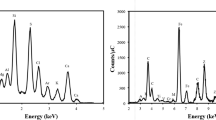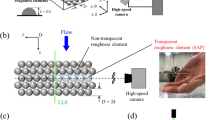Abstract
In this study, we detail a method for estimating the flux-averaged solid fraction of a steady granular flows moving down an inclined rectangular chute using velocity measurements from along the perimeter cross section, combined with knowledge of the mass flow rate through the cross section. The chute is 5 cm wide and 150 cm long with an adjustable inclination angle. Four inclination angles, from 27° to 36° at 3° intervals, are tested. This angle range overlaps the internal friction angle of the glass beads, which are 4 mm nominal in diameter. Two slender mirrors are installed at the top and the bottom of the transparent chute to reflect images of the flow down the chute of the two surfaces. This allows photographic recording of the flow with a PIV imaging system and measurement of the flow depth. The mass flow rate can be calibrated simultaneously by collecting the accumulated mass at the chute exit. A linear interpolation scheme is proposed to interpolate the volume flow rate in each section of the chute. Sensitivity analysis suggests that the relative standard deviation of this scheme is about ±6%, i.e., the resultant solid volume fraction is only moderately dependent on the interpolation scheme for the tested cases. This is further confirmed by a direct intercepting method. Compared to the sophisticated magnetic resonance imaging (MRI) or the radioactive positron emission particle tracking (PEPT) methods, the present method is verified as a cost-effective and nonhazardous alternative for ordinary laboratories. Two distinct groups of streamwise dependence of the solid fractions are found. They are separated by the inclination angle of the chute and agreed with the internal friction angle. In the experiments using the two smaller inclination angles, the solid fraction ratios are found to be linear functions of the streamwise distance, while for the two larger inclination angles, the ratios have a nonlinear concave shape. All decrease with growing downstream distance.














Similar content being viewed by others
References
Adrian RJ (1986) Image shifting technique to resolve directional ambiguity in double-pulsed velocimetry. Appl Opt 25:3855–3858
Ahn H, Brennen CE, HSabersky R (1991) Measurements of velocity, velocity fluctuation, density and stresses in chute flows of granular materials. J Appl Mech 58:792–803
Azanza E, Chevoir F, Moucheront P (1999) Experimental study of collisional granular flows down an inclined plane. J Fluid Mech 400:199–227
Bi W, Delannay R, Richard P, Valance A (2006) Experimental study two-dimensional, monodisperse, frictional-collisional granular flows down an inclined chute. Phys Fluids 18:123–302
Campbell CS, Brennen CE (1985) Chute flows of granular material: some computer simulations. J Appl Mech 52:172–178
Capart H, Young DL, Zech Y (2002) Voronoï imaging methods for the measurement of granular flows. Exp Fluids 32:121–135
Chen KC, Tai YC (2008) Volume-weighted mixture theory of granular materials. Continuum Mech Thermodyn 19:457–474
Ding YL, Forster R, Seville JPK, Paker DJ (2002) Segregation of granular flow in the transverse plane of a rolling mode rotating drum. Powder Technol 28:635–663
Fang C (2008) Modeling dry granular mass flows as elasto-viscohypoplastic continua with microstructural effects. II. Numerical simulations of benchmark flow problems. Acta Mech 197:191–209
Goodman MA, Cowin SC (1972) A continuum theory for granular materials. Arch Ration Mech Anal 44:249–266
Hanes DM, Walton OR (2000) Simulation and physical measurements of glass spheres flowing down a bumpy incline. Powder Technol 109:133–144
Itoh H, Takahama J, Takahashi M, Miyamoto K (2000) Hazard estimation of the possible pyroclastic flow disasters using numerical simulation related to the 1994 activity at merapi volcano. J Volcanol Geotherm Res 100:503–516
Kawaguchi T, Tsutsumi K, Tsuji Y (2006) MRI measurement of granular motion in a rotating drum. Part Part Syst Charact 23:266–271
Kruyt NP, Verël WJT (1992) Experimental and theoretical study of rapid flows of cohesionless granular materials down inclined chutes. Powder Technol 73:109–115
Lim SY, Davidson JF, Forster RN, Paker DJ, Scott DM, Seville JPK (2003) Avalanching of granular material in a horizontal slowly rotating cylinder: PEPT studies. Powder Technol 138:25–30
Liu KF, Mei C (1994) Roll waves on a layer of a muddy fluid flowing down a gentle slope-a bingham model. Phys Fluids 6:2577–2590
Mantle MD, Sederman AJ, Gladden LF, Huntley JM, Martin TW, Wildman RD, Shattuck MD (2008) MRI investigations of particle motion within a three-dimensional vibro-fluidized granular bed. Powder Technol 179:164–169
Nakagawa M, Altobelli SA, Caprihan A, Fukushima E, Jeong EK (1993) Non-invasive measurements of granular flows by magnetic resonance imaging. Exp Fluids 16:54–60
Nedderman SM, Tüzün U, Savage SB, Houlsby GT (1982) The flow of granular materials—I: discharge rates from hoppers. Chem Eng Sci 37:1597–1609
Pitman EB, Le L (2005) A two-fluid model for avalanche and debris flows. Philos Trans R Soc A-Math Phys Eng Sci 363:1573–1601
Pouliquen O (1999) Scaling laws in ganular flows down rough inclined planes. Phys Fluids 11:542–548
Pudasaini SP, Hsiau SS, Wang Y, Hutter K (2005) Velocity measurements in dry granular avalanches using particle image velocimetry technique and comparison with theoretical prediction. Phys Fluids 17:93–301
Pudasaini SP, Hutter K, Hsiau SS, Tai S, Wang Y, Katzenbach R (2007) Rapid flow of dry granular materials down inclined chutes impinging on rigid wall. Phys Fluids 19:53–302
Pugh FJ, Wilson KC (1999) Velocity and concentration distributions in sheet flow above plane beds. J Hydraulic Eng 125:117–125
Shou KJ, Wang C (2003) Analysis of the Chiufengershan landslide triggered by the 1999 Chi-Chi earthquake in Taiwan. Eng Geo 68:237–250
Silbert LE, Ertas D, Grest GS, Halsey TC, Levine D, Plimpton SJ (2001) Granular flow down an inclined plane: Bagnold scaling and rheology. Phys Rev E 64:51–302
Silbert LE, Landry J, Grest GS (2003) Granular flow down a rough inclined plane: transition between thin and thick piles. Phys Fluids 15:1–10
Tai YC, Lin YC (2008) A focused view of the behavior of granular flows down a confined inclined chute into the horizontal run-out zone. Phys Fluid 20:123–302
Takahashi T (1981) Debris flow. Ann Rev Fluid Mech 13:57–77
Tewari S, Tithi B, Ferguson A, Chakraborty B (2009) Growing length scale in gravity-driven dense granular flow. Phys Rev E 79:11–303
Zelinski B, Goles E, Markus M (2009) Maximization of granular outflow by oblique exits and by obstacles. Phys Fluids 21:31–701
Zhang Y, Reese M (2000) The influence of the drag force due to the interstitial gas on granular flows down a chute. Int J Multiph Flow 26:2049–2072
Acknowledgments
The work is supported in parts by the National Science Council, under grants: 98-2221-E-001-011-, 98-2221-E-260-018-, 97-2628-E-008-036-MY3. The authors wish to express their sincere thanks to Prof. K. C. Chen, Institute of Applied Mechanics, National Taiwan University (NTU), and Prof. F. L. Yang, Department of Mechanical Engineering NTU, for in-depth discussions.
Author information
Authors and Affiliations
Corresponding author
Additional information
Li-Tsung Sheng, Chih-Yu Kuo, Yih-Chin Tai, Shu-San Hsiau contribute equally to this work.
Electronic supplementary material
Below is the link to the electronic supplementary material.
Rights and permissions
About this article
Cite this article
Sheng, LT., Kuo, CY., Tai, YC. et al. Indirect measurements of streamwise solid fraction variations of granular flows accelerating down a smooth rectangular chute. Exp Fluids 51, 1329–1342 (2011). https://doi.org/10.1007/s00348-011-1149-4
Received:
Revised:
Accepted:
Published:
Issue Date:
DOI: https://doi.org/10.1007/s00348-011-1149-4




